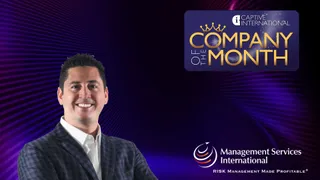
Captives and trucking
Using a captive insurance company for trucking companies: Jeremy Colombik (pictured), of Management Services International, looks at a strategic approach to risk and cost management.
The trucking industry is the backbone of the American supply chain, moving billions of tons of freight annually. However, it faces multiple challenges, razor-thin margins, volatile insurance markets rising and claims and the increase in regulatory scrutiny.
Trucking can be a high-risk, high-cost environment; many trucking companies are turning to captive insurance companies as a strategic alternative to the traditional insurance market. We are learning why captives are gaining traction in trucking; how they work, how they benefit and the considerations that are unique to this industry.
What types of captives can we use?
Captive insurance companies are private insurance companies typically created and owned by a business owner to ensure its own risks. When buying commercial insurance, the premiums are paid to a third-party carrier – captives allow trucking companies to retain their underwriting profits, manuscript coverage and get control over their claims and risk management programmes.
There are multiple types of captive insurance companies:
• Single-parent captives: created to insure the risks of their own business;
• Group captives: owned by multiple insureds who are typically like-minded and have similar risks;
• Cell captives: all unrelated businesses to form a captive while “renting” a captive license to insure their own risks.
Why is the trucking industry turning to captives?
Commercial insurance for trucking has become increasingly expensive and subject to unpredictable rate hikes. These rate hikes can be 15% or more annually even for those companies with good loss history. Captives help the trucking industry by avoiding having to pay for industry wide losses and carriers who are concerned about their profit margins. In a captive, premiums are typically based on the company's own risks and loss history this can often result in lower costs and more pricing stability over time.
Captives allow for custom manuscript policies. Standard commercial insurance policies can be rigid, leaving gaps or forcing trucking companies to pay for unnecessary coverages that they don't need. Captives allow trucking companies to manuscript their policies around their own unique operation of risks; this can be from auto liability and physical damage to cargo workers comp and employment practices liability. This flexibility is especially valuable for specialised or non-standard trucking operations.
When a captive's claims are lower than expected, the unused premium dollars are retained in the captive and can be returned to the owners as dividends or to create a surplus strengthening the captive’s solvency. This can create a direct financial incentive to invest in safety and risk management in your trucking company.
Many trucking companies struggle with the transparency in control over the claims process and are looking to take more control of this process, this often leads to faster resolution and better outcomes.
Instead of writing large premium cheques to the carriers, captives allow trucking companies to fund their own risk sometimes at a lower cost. Over time, the captive can build up a surplus which can be reinvested in the business or used to take on more risks or a larger part of any one risk.
Captives are not a fit for every company as they tend to work better with companies that have strong financials and already have good risk management protocols in place. Having a robust safety programme, with low CSA scores, and investing in driver training and telematics are recommended for a company looking to insure their risks in a captive.
Forming a captive can give you direct access to the reinsurance market, often securing better terms or filling in those gaps that are often left by commercial insurers.
Captives can assist you when you are looking to insure risks that are prohibitively expensive or unavailable in the commercial market.
Single-parent captives often start with a feasibility study followed by the formation, and capitalization, of your new insurance company.
The next step includes selecting your policies and working with an actuary to determine appropriate pricing for the selected risks. This pricing is based on the risks and loss experience of your trucking company rather than an industry wide average. Once premium is paid, policies are issued to your business(es) These policies can vary by each company but include crucial risks such as auto liability, garage keepers, on hook, cargo and physical damage.
Grabbing control of your claims management is a crucial piece of the puzzle as this is where you can gain more control over the claims experience in the commercial market. You can choose, with an approved third-party administrator, to handle your claims where you can retain authority over claims decisions, settlements and fight claims you feel are fraudulent.
At the end of each policy period, you will go through a renewal akin to those you have experienced with the commercial market. When the policy period has ended, you can start to calculate your underwriting profits and either take a dividend or leave them in your captive to build up the surplus, creating greater solvency. The surplus can be invested, generating additional investment income and helping to provide greater solvency.
Your captive must comply with the insurance regulators in its domicile, including reporting solvency and government requirements. Your captive manager will handle all these items for you while communicating with you along the way.
While there are significant advantages with single-parent captives, they do require upfront capital and an ongoing financial commitment. Expertise in insurance operations, claims and regulatory compliance, along with a risk aversion to claims experience as poor loss performance, can erode your surplus and require a capital infusion.
For large, safety focused trucking companies, a single-parent captive insurance company can be a powerful tool to control their insurance costs, manuscript coverage and improve their risk management by retaining underwriting profits and gaining transparency.
While directly influencing claims and safety outcomes trucking companies can transform insurance from a volatile cost centre into a strategic asset. However, a captive success requires careful planning, strong financials and a commitment to operational excellence. For those prepared to make the leap, the rewards can be substantial both in financial performance and long-term stability.
Did you get value from this story? Sign up to our free daily newsletters and get stories like this sent straight to your inbox.

